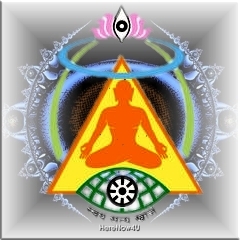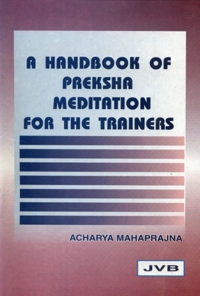
1. Posture:
You may select a posture of meditation in which you can sit comfortably and steadily for a long period.
The posture of meditation may be full lotus-posture, half lotus-posture, simple cross-legged posture or diamond posture (Vajrasan).
2. Mudras: Position of the hands
There are two alternatives,
one position is called Jnana Mudra.
Keep your right hand on the right knee and left hand on the left knee.
Keeping the palms turned up, let the tip of the index finger touch the tip of the thumb with a slight pressure between them. Keep the other fingers straight.The alternate position is called Brahma Mudra.
Keep both the hands on your lap one above the other by keeping the palms up-turned.
Let the left palm remain under the right one. Keep your eyes softly closed.
3. Recitation of the Mahaprana Dhvani:
Let us start meditation with the repeated recitation of the Mahaprana Dhvani.
All of you should join in the repetition of Mahaprana Dhvani.
Exhale fully, then inhale deeply as long as you can.
By slow exhalation, produce the sound mmm.... through the nostrils like the buzzing of a bee, while concentrating your mind on the Centre of Knowledge situated on the top of the head and keeping the mouth closed.
Inhale deeply again and repeat the same exercise 9 times.
4. Kayotsarga:
Keep your body steady, relaxed and free from tension.
Keep your spine and neck straight but without stiffness.
Relax all the muscles of your body.
Let your body become limp.Kayotsarga has two implications -
- complete relaxation of the body and
- self-awareness.
For achieving complete relaxation of the body, mentally divide it into several parts and concentrate your mind on each part of the body one by one from feet to head.
Allow your mind to spread in the whole part; allow it to undertake a trip in the whole part.
Use the technique of auto-suggestion to relax the whole part and experience the resulting relaxation.
Experience that each and every muscle, each and every nerve has become relaxed.
And in the same way, attain the relaxation of the whole body.
Use deep concentration and remain completely alert.Practice Kayotsarga.
The success of the exercise depends upon the deep relaxation of the body.
5. With your mind's eye, visualise that everything around you, including the air itself, is coloured bright rosy pink.
Take a deep breath and as you slowly inhale, visualise that you are breathing long streams of bright pink air. Repeat the breathing exercise several times, each time inhaling bright pink air. Visualise that bright pink air is entering into your lungs with each inhalation.
6. Concentrate your full attention on the Centre of Bliss situated near the heart and recite nine times loudly:
My fearlessness is increasing. My instinct of fear is diminishing.
Now repeat the same sentences mentally 9 times:
My fearlessness is increasing. My instinct of fear is diminishing.
7. Contemplate on the high moral value of this virtue on the following line:
Fear withers even the developed abilities and does not permit the latent ones to be developed.
I must, therefore, strive to attain the virtue of fearlessness.
Everybody tries to frighten one who is afraid.
Fear makes one a coward.A coward does neither attract respect nor sympathy.
I firmly resolve to attain fearlessness to develop latent inner strength.
Undoubtedly I will attain freedom from fear.
8. Conclude the meditation session with recitation of Mahaprana Dhvani.

 Acharya Mahaprajna
Acharya Mahaprajna

